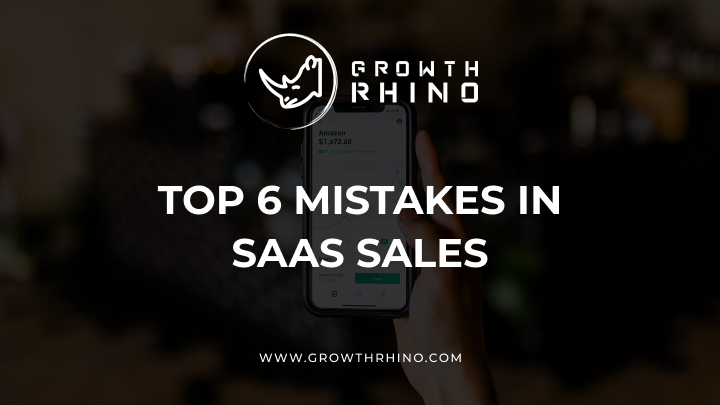
Sales are one of the most challenging aspects of any business, even more so for SaaS companies. Many things can go wrong, and if you're not careful, you can quickly find yourself out of business. This post will look at the six most common mistakes in SaaS sales and how to avoid them. So read on and make sure you're not making these costly mistakes!
1. Not having a transparent sales process
Having a clear and organized sales process is essential for SaaS businesses. Without a well-defined system, it's easy for leads to fall through the cracks and for opportunities to get lost in the shuffle. Moreover, sales team members who need a concrete procedure to follow may need help with critical tasks such as setting up demos or following up with prospects.
An unclear sales process can lead to missed revenues; at worst, it can cripple the business entirely. Fortunately, there are steps SaaS companies can take to create an efficient and effective sales process. This includes recognizing customer pain points and determining objectives, mapping out a timeline of customer touchpoints, laying out what content should be shared at each step, setting clear goals for reps and managers alike, making sure customer data is accessible across departments, establishing rules of engagement between customer care and lead/sales teams, creating segmented CRM processes tailored to different customer types if needed, implementing an early alert system if progress stalls on specific deals, etc.
An effective SaaS sales process allows SaaS firms to maximize their existing resources and effectively track customer growth. Having this kind of clarity helps SaaS companies focus on delivering results in a shorter time frame with higher quality levels — driving far more growth than would otherwise be possible. So don't wait — start putting together your SaaS sales processes today to stay ahead tomorrow!
2. Focusing too much on features and not enough on benefits
A mistake many people make when promoting a product or service is focusing too much on features and not enough on benefits. A feature is an aspect of the product, such as its size, design, or specifications. On the other hand, a benefit highlights the value gained from the product and how it will make your life more convenient or enjoyable.
Focusing solely on features means you're missing out on offering customers real value for their money — significant when trying to sell something. Instead, try to identify the particular advantages offered by the product or service for potential buyers and craft messaging around those unique benefits so potential customers can easily visualize themselves using it.
Be sure to explain why this purchase would help them achieve whatever goal they have in mind, whether it be more leisurely laundry days or quicker meal prep time. Remember, people do not buy features — they buy solutions! So focus your sales pitch on highlighting benefits to show potential customers what the product can provide them.
There's nothing wrong with noting some critical features if they contribute to understanding how these benefits are achieved. However, always appreciate the power of emphasizing benefits over features; they genuinely matter in any sale.

3. Not qualifying leads early enough in the process
Another of the biggest mistakes businesses can make when trying to attract and convert new customers is not qualifying leads early in the process. Taking time at the start of the funnel to separate genuine prospects from tire-kickers or uninterested parties can save time and resources down the line. For example, asking for an email address up front in exchange for a free report about your product or service can help steer clear those who are merely window-shopping.
Alternatively, beginning conversations with a short questionnaire that seeks to uncover prospective customers' needs and motivations can be a helpful way to qualify leads quickly. Challenging questions like 'What would you do with this offer?' are often enough to begin separating our committed potential customers from those who are there merely out of curiosity.
Qualifying leads early on in the funnel is essential if businesses want to increase their conversion rates and ensure they're helping only those buyers that genuinely need their products. Doing so well helps build trust, as prospects know they will be taken care of properly during and after the sale, ultimately leading to more satisfied customers — the goal of any devout business!
4. Closing deals too quickly
Nobody wants to find themselves in a situation where they've closed a deal too quickly without fully understanding the implications. Unfortunately, it's easy to be sucked into the moment when you're in a negotiation, especially if the other party is eager to close the deal.
The key is not to let your emotions take over and remember that there are always details that need to be ironed out before a contract can be signed. Be sure to do your due diligence, carefully review the agreement's terms, and understand exactly what you agree to. Ask questions if anything needs to be more straightforward, and take plenty of time to consider your options.
Do more than take someone else's word for something; gather as much information as possible first so that you can make an informed decision before signing on the dotted line. This way, you'll ensure that you don't close any deals too quickly and regret them later.
5. Not tracking progress and results closely enough
Many different metrics drive SaaS sales, yet they all focus on one thing: progress and results. To see success, you must track your SaaS sales progress and results and adjust course when it's warranted. Measuring growth is essential and requires an acute eye to identify what works, where improvements can be made, or when to take action to sustain momentum.
SaaS businesses that fail to track their progress and results closely enough miss opportunities for growth and development and may struggle against competitors who do. Taking the initiative to understand SaaS sales performance at regular intervals is key to optimizing user experience and staying ahead of the competition. By tracking progress and measuring results regularly, SaaS businesses can make well-informed decisions about how best to reach their goals.
Acting swiftly when problems arise can be the difference between success and failure–not tracking progress carefully enough could result in costly mistakes. That's why B2B SaaS marketers often have no choice but to apply a practical yet data-driven approach to ensure SaaS sales targets are hit with accuracy.
Rely on data collection metrics more seriously as these will tell accurate stories about business performance, thereby ascertaining cause-and-effect practices for new decision-making. Establishing check-ins with analytics dashboards before progressing further is the safest way forward upon navigating through SaaS sales growth initiatives. Knowing this information could make or break your ability to stay competitive, so start tracking those numbers!

6. Not training sales reps adequately
Having a poorly trained sales team is one of the quickest ways to lose your competitive edge in SaaS sales. Whether you are new to SaaS or have been selling on the platform for years, it pays to invest in proper training for your reps. With SaaS sales, agents need to be well-versed in features, functionalities, and nuances like customer preferences and competition. Without understanding these basics, they will be unable to maximize their conversations with potential buyers.
Moreover, failing to keep your reps up-to-date on SaaS platform changes could lead them to miss out on critical revenue opportunities. As SaaS grows more complex, it's vital that sales reps can quickly comprehend and adapt to these evolving dynamics — or else they'll fall behind their competitors and cost your business dearly.
Investing in adequate training and professional development will set your reps up for success while helping you stay ahead of the curve with SaaS sales. It may take a bit more time and money upfront, but doing so is essential if you want long-term success.
Last words
If you're having trouble making sales, it might be due to one of these six common mistakes. You can increase your chances of success by improving your sales process and focusing on the right things. Utilizing the right strategies, understanding the customer's needs, avoiding common missteps, and investing in proper training can help ensure that your SaaS sales team enjoys long-term success. With these tips, you will surely be well on your way to a triumphant SaaS venture!
